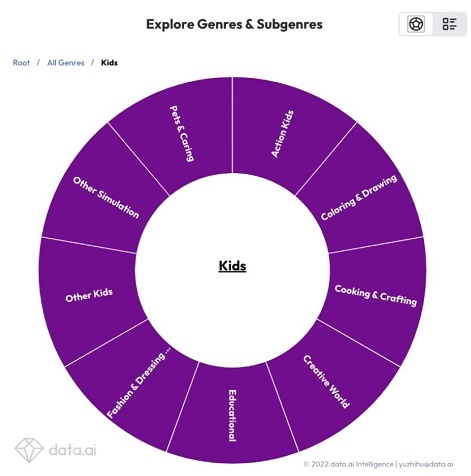This article is part of an ongoing series of data-driven articles from PocketGamer.biz and data.ai (formerly App Annie) highlighting trends in the global mobile games sector using data.ai’s Game IQ analytics.
Gaming is a pastime that crosses demographics, but it’s easy to leave children out of the mix in the mobile space. Bringing children’s games to market means navigating strict regulations regarding content and privacy, which can make successfully monetising them a daunting prospect.
To help combat this, data.ai has introduced a kids’ classification through its Game IQ taxonomy to give developers the tools necessary to grow their children’s games.
Data.ai classifies children’s games as those having a focus on education, bright colours, cheerful music, and limited monetisation options, and suggests that developers in the space need to understand the features driving user acquisition and retention. “It’s important to understand how to appeal to both the kid who will play the game and the parents who will download it.”
Data.ai separates the genre into a number of distinct subgenres, each of which contains unique data points that indicate what’s driving success for young gamers.

Child’s Play
The data shows that the kids’ genre is fourth in terms of downloads, behind hypercasual, simulation and action titles. Despite this, the genre is in ninth place in terms of revenue. Data.ai suggests that the reason for this is that such games don’t monetise as aggressively as other genres. As such, developers hoping to monetise children’s titles need to test and evaluate different monetisation strategies if they hope to profit. Whereas in-app purchases aren’t popular within children’s titles, paid downloads, subscriptions and advertising can all help developers generate revenue.
The most profitable subgenre of children’s games is what Data.ai calls “Kids - Creative World” - games that “afford kids the opportunity to tell their own story through gameplay”. Such games give players a large map where players can unlock and build various buildings and functions.The article states that “this subgenre stands atop the kids genre in driving revenue, and the games within it are continuously optimising their purchase funnel.”
Unlike other subgenres of kids’ games, Creative World games tend to feature more frequent in-app purchases, and developers have worked to discover a variety of monetisation strategies.
However, game makers still need to contend with a variety of factors such as “updated privacy guidelines, COPPA (the Children’s Online Privacy Protection Act of 1998) and younger demographics.” It’s as important to successfully advertise to parents and caretakers as it is to children, if not more so, as they are driving the decision regarding the content their children consume.
Earlier this month, the UK’s Information Commissioner's Office examined how the industry has reacted to the passing of the Children’s Code.























